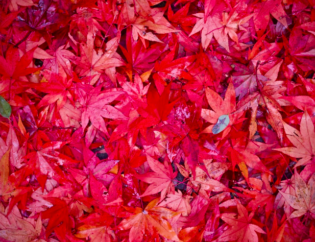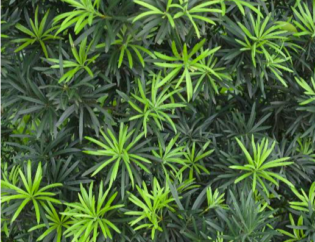Have you been struggling with some plants in the past few years?
We are beginning to realize that the pH of the water and soils in our area is rising. This is leading to issues with plants that have not previously had many issues with like Red Maples, fruit trees, annuals and more.
The pH of the soil is very important. While I won’t bore you with too many details, the pH allows the availability of nutrients. Not all nutrients are available in the same quantities at the same pH either. While most plants prefer a pH of 6.5 many will tolerate it between 6 and 7. I like this chart from Cornell University about nutrient availability. If you notice in the chart that the nutrients that become unavailable in the soil at high pH levels are the nutrients that can contribute to chlorosis among other things. This is why chlorosis is, in my experience, one of the most frequent and first symptoms of a soil with higher pH.
Chlorosis is the symptom of the plant not being able to take up certain nutrients like nitrogen, iron, zinc and magnesium, just to name a few. Sometimes it is because that nutrient is just not present in high enough amounts in the soil, more recently in our area, it is because the nutrients are there but not available to the plant due to the higher pH. Chlorosis symptoms are yellow or partially yellow leaves with green veins and in severe cases, irregular brown edges or patches. The exact pattern of yellowing depends on the plant and severity. A few photos of chlorosis on different plants are below.
What to do?
While the cause of the rising pH levels in our soils is beyond our control, we can manage the pH down to a more preferable level for our beloved plants. So if you are seeing symptoms shown above despite ensuring that you are not overwatering, you should treat the soil. For those who have plants that are still leafing out yet had these symptoms last year, it would be a good idea to treat at least once with soil sulfur each spring for most plants. Acid loving plants should be treated spring and fall with soil sulfur to help maintain lower pH.
If you are worried about lowering it too much, don’t stress. Applying the recommended products below and as directed will not cause the pH to be too low in our soils here in California’s Central Valley. Changing pH is very slow. Every point in pH is ten-fold. So a pH of 7 is 10 times more alkaline than a pH of 6, and a pH of 8 is 100 times more alkaline than a pH of 6. Hopefully that makes a little sense. Here is a quick (not comprehensive) list of what plants you should treat at least annually:
- Red Maples (Acer species)
- Japanese Maples (Acer palmatums)
- Mophead and Oakleaf Hydrangeas – except pink mophead. For more information on hydrangeas see All About Hydrangeas.
- Fruit Trees – Stone fruit, Citrus, Tropicals, etc
- Grapes
- Cane Berries
- Any container grown plants
- Acid-loving plants – Azaleas, Gardenias, Camellias, Peonies, Blueberries, etc.
- Hibiscus
- Bougainvilleas
There are 2 main active ingredients available to consumers. One is Aluminum Sulfate and the other is Soil Sulfur. Soil Sulfur will be listed on the active ingredients as Free Sulfur or Elemental Sulfur. Aluminum Sulfate will be listed on the active ingredients as Combined Sulfur. There are differences in how these to products work. Aluminum Sulfate works quicker and doesn’t last as long. It will typically leach out in a couple of months. Soil Sulfur takes a little longer to work but will last several months. You can choose which you prefer to use.
We recommend
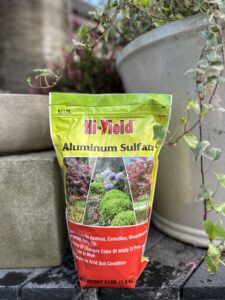
Hi-Yield Aluminum Sulfate – apply amount recommended on label. Test soil in 2 weeks and reapply if needed.
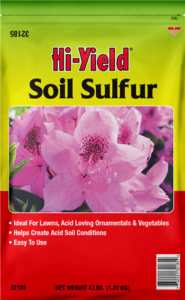
Hi-Yield Soil Sulfur – apply amount recommended on label. Test soil in 2 months and reapply if needed.
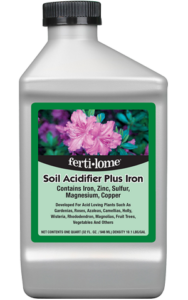
Fertilome liquid Soil Acidifier Plus Iron – mix with water as directed on the label. If plant is actively growing and symptoms do not improve in 2 weeks, reapply. Repeat as long as symptoms appear or if pH is not in desired range.
For those who want to learn more, see links below:
Understanding Soil pH by Michigan State University




